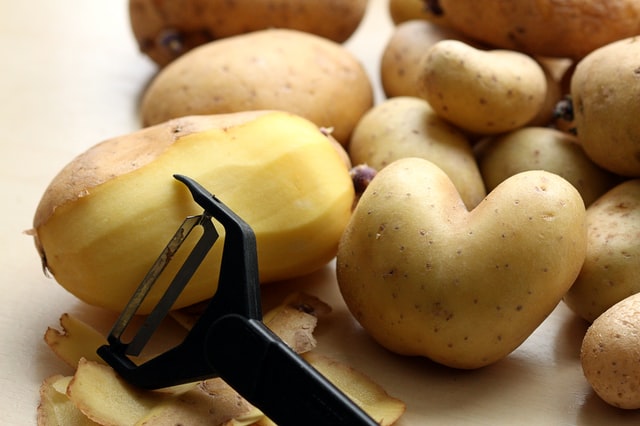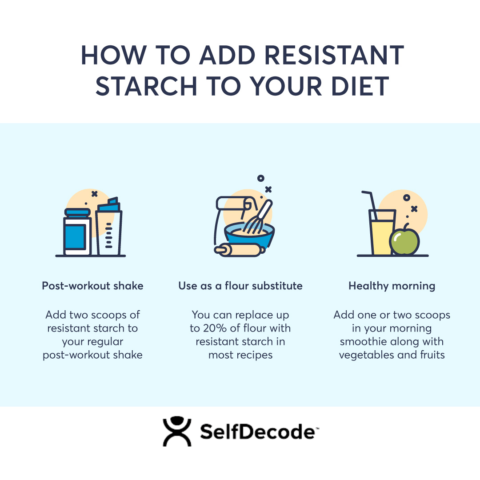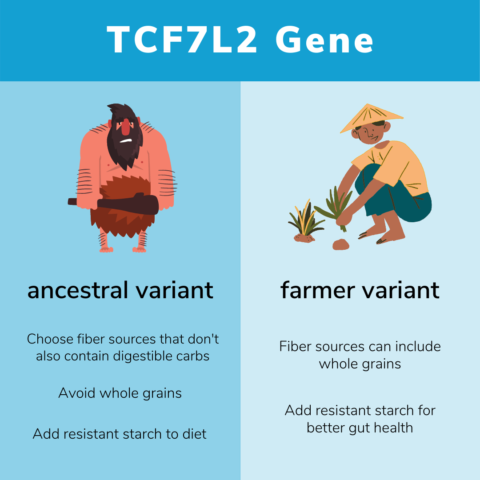
Resistant starches can offer many benefits when added to your diet, but there are a few things you should know before you try it. Read on to find out everything you need to know about the benefits of resistant starch, foods to add to your diet, and what to look out for.
What is resistant starch?
First things first: what are starches? Starch is a type of carbohydrate that is commonly found in the main foods that you eat every day, like cereal, potatoes, and rice. They’re just sugar molecules joined together.
Since many health organizations around the world recommend that carbs, in general, make up between 45% – 65% of your diet, they shouldn’t be unfamiliar to you. Depending on the type of starch you choose to eat, however, it may cause your blood sugar levels to spike rapidly.
Resistant starches are simply starches that are resistant to digestion in the small intestine. This means that they aren’t broken down into sugar and absorbed in the small intestine. Rather, they go on to get fermented by the gut bacteria in the large intestine.
In other words, they help feed the good bacteria present in your gut – and they don’t raise your blood sugar.
Not all foods contain high amounts of resistant starch, and it can be often destroyed during the cooking process. That’s why you need to pay close attention when choosing which foods to eat if you want to include this type of starch in your diet, and how you’re going to prepare it.
Types of resistant starch
Not all starches are the same. There are five different types, classified according to their sources:
- RS Type 1: Starch that’s physically inaccessible to digestion, as found in legumes such as beans and lentils.
- RS Type 2: Naturally resistant starch due to its structure. It can be found in starchy foods like green bananas and raw vegetables like potatoes.
- RS Type 3: It’s formed after types 1 and 2 are cooked then cooled, and can be present in foods such as bread, pasta, rice, and potatoes.
- RS Type 4: Starch that has been chemically modified to resist digestion, found in processed foods like bread and crackers.
- RS Type 5: It’s created through a process that involves heating and cooling starchy foods with particular lipids.
All types of resistant starch can be good for you, but each has a different effect on the body. What’s more, a single food item can have more than one type.
Is resistant starch good for you?
The health benefits of resistant starch are many, contrary to what you may think. Here we’ll outline a few improvements you may experience after you start including resistant starches in your diet.
Blood sugar
By following a resistant starch diet and including starchy foods in your daily routine, you may see an improvement in your insulin sensitivity (how your cells respond to insulin). Plus, it can also help lower your blood sugar levels after meals.
If you have low insulin sensitivity, you can be at risk for several other diseases such as type 2 diabetes and heart disease – insulin resistance is believed to be a major risk factor for these and many other health conditions.
Gut health
Resistant starches can also help increase the number of good bacteria in your gut, which can result in many health benefits, like enhancing your immune function. It can also improve how well you absorb nutrients.
When you eat these foods, the bacteria in your gut turn them into short-chain fatty acids, the most important one being butyrate, essential for maintaining a healthy gut. It’s the preferred energy source for the cells in your colon and helps maintain a strong intestinal barrier.
As other benefits of butyrate, it can help prevent gut inflammation and improve inflammatory bowel disease symptoms. It can even have protective properties against colon cancer.
Brain Function
Your gut health has a strong impact on brain function This happens because of the gut-brain axis, a term used to describe the communication between your gastrointestinal tract and your central nervous system.
The butyrate produced in your gut when you eat resistant starches may also improve learning and long-term memory – it can help with the creation of new brain cells, a process called neurogenesis. The more neurons you have as you age, the better your cognitive function will be as well.
One particular butyrate-producing bacteria present in your gut may also help prevent your brain from not getting enough oxygen, a condition called vascular dementia. What’s more, butyrate may also help protect against neurodegenerative diseases like Alzheimer’s disease.
Mood
If you add resistant starch to your diet, you may also see an improvement in your mood, as butyrate can increase your dopamine levels. This can help relieve depression and stabilize other mood disorders.
Resistant starch & weight loss
Another good news is that adding resistant starch to your diet may help you control your weight. By ingesting it, you can increase the production of an appetite-reducing hormone, which promotes satiety and fullness.
Plus, resistant starch foods aren’t calorie-dense, meaning that you’d need to ingest a higher amount of food to meet your caloric daily requirements.
Which foods are high in resistant starch?
There are many different types of foods that you can add to your diet if your goal is to increase your intake. Here we’ll provide you with a short resistant starch foods list you can add to your diet, but keep in mind that there are other alternatives.
Cooked and cooled starchy carbs
When you cook and cool starchy foods, they can become less digestible. This happens because some starches lose their original structure during cooking. After they’re cooled, a new structure is formed, which is more resistant to digestion.
Steaming, pressure cooking, and stir-frying rice result in more resistant starch than simply boiling it. Cooling your rice also increases its resistant starch content.
Although it’s not a very well-studied subject, it may be possible to increase resistant starch in pasta by cooking and subsequently letting it cool before eating.
Tip: Cooked and cooled starchy foods can be reheated at low temperatures and still maintain resistant starch content.
Whole grains
Whole grains such as oats are a good example of a convenient and cheap way to add resistant starch to your diet. Cooking and cooling your oats can increase the resistant starch content, or you can try uncooked oats soaked in milk (dairy or non-dairy) overnight.
Beans and other legumes
Beans and legumes are excellent sources of resistant starch, but they should be soaked and fully cooked before you eat them to remove lectins and other antinutrients. Keep in mind that different types of beans yield different amounts of resistant starch.
Green bananas
Unfortunately for those who prefer to eat ripe and sweet bananas, green bananas have the most resistant starch content. Similarly, if you cook a banana, it will lose resistant starch.
Supplemental sources
Raw potato starch
Raw potato starch has a high content of resistant starch and a low glycemic index, meaning it won’t cause your blood sugar to spike too much. It can be added to smoothies and other dishes uncooked.
High-amylose corn starch
High-amylose corn starch is a type of fiber that has a higher content of amylose, one of the two types of molecules that make up starch, which is less digestible.
Hi-Maize
Hi-Maize is a high-amylose resistant starch that has been treated to increase its resistant starch content. It’s a good alternative if you’re sensitive to plant-based starches, as its processing destroys most plant-based immune stimulants. However, if you’re allergic to corn, you may want to steer clear of it.
How to add resistant starch to your diet
You can introduce resistant starch to your diet by adding it to your pre or post workout shake, or add it to your morning smoothie. Resistant starch can also replace up to 20% of flour in most recipes. Besides all the foods listed above, there are some additional sources of resistant starch. Keto dieters may benefit from these supplemental sources, as it may be difficult to get enough from food without getting too many digestible carbs.

For those who like to save time in the kitchen, this might be good news for you: you can cook a big batch of starchy foods and let them cool to increase their resistant starch content. This way, you’ll have your meals ready to go during the week – just add vegetables and a protein source for a complete meal.
Negative effects of adding resistant starch to your diet
As with anything, there are a few limitations and side effects for including resistant starch in your diet.
One side effect you may experience after increasing your intake of this type of carbohydrate is gas and bloating. This stomach discomfort can happen because some high resistant starch foods cannot be fully digested.
Also, keep in mind that the positive health effects you may experience depend on the type of starch you consume. What’s more, they depend on your gut microbiome composition. That’s why your resistant starch diet should be personalized to your specific needs to be the most beneficial.
Resistant starch and genetics
If you want to improve your overall health by adding this type of food to your diet, you may first want to learn what your health risks are. SelfDecode can help you uncover how your genetics are affecting, among others, your:
- Gut health
- Inflammation
- Body weight
- Blood sugar
- Cognitive Function
How exactly does DNA influence how you’ll respond to resistant starch?
Let’s take a look at the TCF7L2 gene. People with certain variants of this gene don’t seem to handle carbs well. If that’s your case, you may need to limit high-fiber carbs like whole grains, which are protective against diabetes in other people. To reap the benefits of fiber, adding resistant starch to your diet may be a good option to help you maintain healthy blood sugar levels.
The SelfDecode Blood Sugar DNA Wellness Report looks at over one million genetic variants to give your genetic risk score and personalized recommendations to help you manage your levels. Depending on your DNA, you might experience more benefits from adding resistant starch to your diet than the next person.
For more information on your gut health, SelfDecode offers Irritable Bowel and Gut Inflammation DNA reports that analyzes tens of thousands genetic variants to show your likelihood of experiencing gut issues and other gut disorders. If you know what your predispositions are, you can adjust your diet according to your own tolerances.
With SelfDecode, you’ll get personalized and prioritized diet, lifestyle, and supplement recommendations, all based on your DNA and aimed at improving your quality of life. A subscription to SelfDecode also includes access to LabTestAnalyzer, a specialized tool developed to track and analyze your lab markers, including blood sugar and gut health analysis.
Takeaway
Adding resistant starch foods to your diet can help you improve your gut and overall health. Plus, most of these food items are affordable and easy to find. Just remember that how you prepare your food may impact its resistant starch content.
The best way to start introducing it to your diet is to understand how your body will react to it and what your needs are. A tool like SelfDecode can help you find out how your genes play a role in your health so you can better prepare and feel all the benefits with minimal (or no) side effects.
Learn More
- What Does Lactose Intolerance Feel Like?
- Brain Fog Causes: What You Need To Know
- Is Diabetes Genetic? Ways Your Genes Can Affect Blood Sugar


